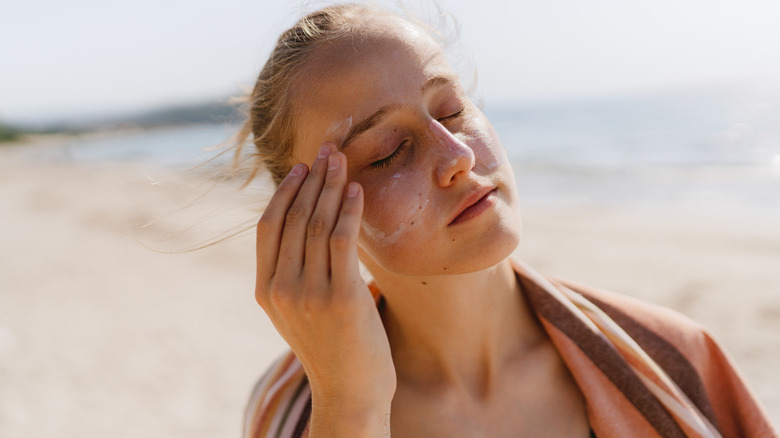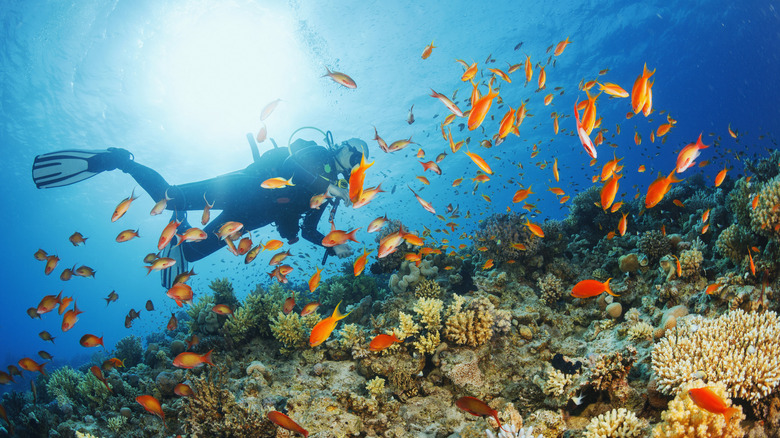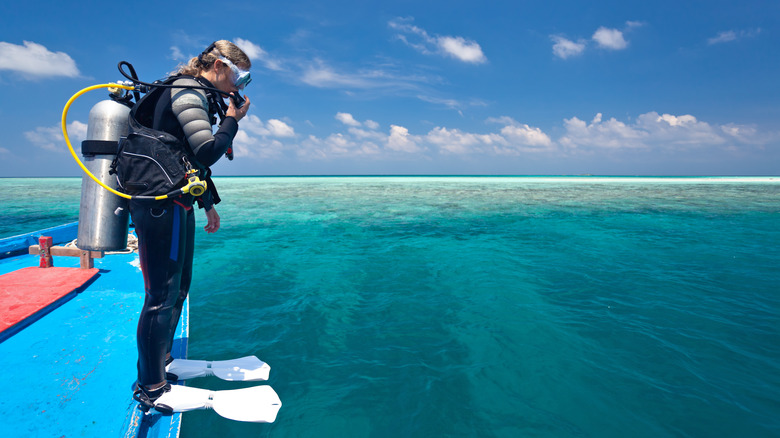You May Want To Think Twice About Using Basic Sunscreen Before Scuba Diving
A little fun in the sun never hurt anyone, right? Well, not so fast. While you're lathering up on sunscreen for a long day of boating and scuba diving, some risk is involved — and it's not just your skin. It's actually the marine ecosystem, as toxic chemicals can rub off your body and leech into the water. There's a whole host of side effects for marine plants and wildlife, from the daintiest coral to large mammals. For plants like algae, sunscreen chemicals can inhibit growth and interrupt photosynthesis, the process of turning sunlight into nourishment. For coral reefs, it can spell damage to DNA and bleaching. For mussels, fish, and dolphins, the chemicals can accumulate in tissues, decrease fertility, or cause deformities in their offspring.
It's estimated that 14,000 tons of sunscreen get into the waterways annually, the same as 25 to 60 million bottles, per the Smithsonian National Museum of Natural History. The chemicals are so harmful to marine life, in fact, that half a dozen destinations have already banned it, including Palau, the U.S. Virgin Islands, Aruba, Bonaire, Hawaii, Key West in Florida, and some ecological reserves in Mexico, like Xcaret and Xel-Há.
Sunscreen isn't just toxic for the ocean, either. Due to potential health implications for humans, the Food and Drug Administration (FDA) has proposed an update on sunscreen requirements to ensure they are truly safe and effective, notes a press release. Now might be time to toss your traditional sunscreen aside and lather up with some reef-safe lotion instead.
How to find a reef-safe sunscreen
While it should be simple enough to buy a bottle that says "reef-friendly" on the label, the term is not well regulated. Essentially, companies can advertise whatever they want. For the true winners, look at the list of active ingredients on the back. Avoid any sunscreen that contains oxybenzone, avobenzone, which is common in spray sunscreens, octinoxate, octocrylene, 4-methylbenzylidene camphor, PABA, parabens, triclosan, or microplastics like exfoliating beads. Here's a simple one-pager that you can bring to the store.
The size of the particles also matters. You might see nano zinc or titanium, which stands for nano-sized, but ocean conservationists via Beachapedia say that their small size makes these particles more likely to rub off your skin into the water. Your safest bet is larger-sized particles, like micro or non-nano. Luckily, there are nearly two dozen brands on the market that can help take out all the guesswork. Each mineral sunscreen is made with only one or two active ingredients, like zinc and titanium oxide. Some truly reef-safe brands include REN Clean Screen Mineral Mattifying Sunscreen SPF 30, which can be found on Amazon, Badger Reef Safe Sunscreen SPF 40 via Amazon or Target, and Kōkua Sun Care SPF 50 found on Amazon or Walmart.
Tips for reef-safe sun protection
In a tropical location, keep in mind that the sun is more intense than destinations at higher latitudes. While on the shore, look for shady spots or set up an umbrella. On the boat, heading to a coral reef, wear a hat, polarized sunglasses, and chapstick with SPF. Scuba divers are particularly susceptible to sunburn, so reapply sunscreen every two hours, including those easy-to-miss areas like your neck and ears. You can also avoid peak sun hours between 10 a.m. and 4 p.m., the time of day when UV radiation levels are known to be the highest.
Once you're in the water, UVB rays (the ones that cause those painful sunburns) can still be a problem. Roughly 40% of UVB rays can reach you at 1.5 feet under the water, says BBC Science Focus. While this is unfortunate for snorkelers near the surface, divers may fare a little better farther down beneath the waves. Your sunscreen will wash off, of course, but your gear can help protect you. A diving suit will automatically cover much of your body's surface area, or in warmer areas, you can opt for a rash guard or swim shirt. As for the top of your head, keep it protected with a hood made of lycra. However, before you purchase any clothing, look for the term Ultraviolet Protection Factor, or UPF for short. It's similar to SPF but for fabrics. With a few sun tips, you'll protect your precious skin and those majestic sea critters you love to dive with.


